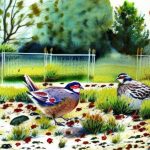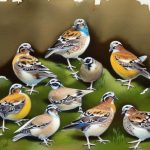Singing quails, also known as Chinese painted quails, are small, colorful birds that are popular among bird enthusiasts for their melodious calls and vibrant plumage. Breeding singing quails can be a rewarding and enjoyable experience for those who are passionate about aviculture. Singing quails are relatively easy to care for and breed, making them an ideal choice for beginners and experienced breeders alike. In this article, we will explore the various aspects of singing quail breeding, including choosing the right breeding pair, creating the ideal breeding environment, understanding the breeding cycle, caring for chicks, common challenges, and tips for successful breeding.
Table of Contents
- 1 Choosing the Right Breeding Pair
- 2 Creating the Ideal Breeding Environment
- 3 Understanding the Breeding Cycle of Singing Quails
- 4 Caring for Singing Quail Chicks
- 5 Common Challenges in Singing Quail Breeding
- 6 Tips for Successful Singing Quail Breeding
- 7 FAQs
- 7.1 What is singing quail breeding?
- 7.2 What are singing quails?
- 7.3 What are the basic requirements for breeding singing quails?
- 7.4 What are the benefits of breeding singing quails?
- 7.5 Are there any legal considerations for breeding singing quails?
- 7.6 What are some challenges associated with breeding singing quails?
Key Takeaways
- Singing quail breeding requires careful consideration and planning to ensure success.
- Choosing the right breeding pair involves selecting healthy, unrelated birds with desirable traits.
- Creating the ideal breeding environment involves providing a spacious, well-ventilated, and predator-proof enclosure.
- Understanding the breeding cycle of singing quails is crucial for successful breeding and hatching of chicks.
- Caring for singing quail chicks involves providing proper nutrition, warmth, and protection from predators.
- Common challenges in singing quail breeding include infertility, egg binding, and predation.
- Tips for successful singing quail breeding include regular health checks, proper nutrition, and minimizing stress for the birds.
Choosing the Right Breeding Pair
Selecting the right breeding pair is crucial for successful singing quail breeding. When choosing a breeding pair, it is important to consider the health, age, and genetic diversity of the birds. Look for birds that are active, alert, and free from any signs of illness or deformities. It is also advisable to choose birds that are at least six months old, as younger birds may not be mature enough for breeding. When selecting a breeding pair, it is essential to ensure that they are not closely related to avoid inbreeding, which can lead to genetic abnormalities and health issues in the offspring. Additionally, choosing birds with diverse genetic backgrounds can help maintain the overall health and vitality of the breeding stock. By carefully selecting the right breeding pair, breeders can increase the likelihood of producing healthy and robust chicks.
Once you have chosen a breeding pair, it is important to provide them with a spacious and comfortable living environment. A large aviary or cage with plenty of room for the birds to move around and exercise is essential for their well-being. The enclosure should also be equipped with appropriate nesting boxes or shelters where the birds can lay their eggs and raise their chicks. Additionally, providing a variety of perches, hiding spots, and natural materials such as straw or grass can help create a stimulating and enriching environment for the birds. It is also important to ensure that the enclosure is secure and predator-proof to protect the birds from potential threats. By creating an ideal breeding environment, breeders can help promote the health and reproductive success of their singing quails.
Creating the Ideal Breeding Environment
Creating the ideal breeding environment for singing quails is essential for their reproductive success. Singing quails are ground-dwelling birds that require a well-designed enclosure to thrive and breed successfully. When setting up the breeding environment, it is important to provide the birds with a substrate that mimics their natural habitat, such as sand or fine gravel, which allows them to dust bathe and maintain their plumage. Additionally, providing a variety of natural materials such as dried grass, leaves, and twigs can help create a comfortable and stimulating environment for the birds. It is also important to ensure that the enclosure is equipped with appropriate nesting boxes or shelters where the birds can lay their eggs and raise their chicks in privacy.
In addition to providing a suitable substrate and nesting areas, it is important to maintain optimal environmental conditions within the breeding enclosure. Singing quails thrive in moderate temperatures ranging from 60-75 degrees Fahrenheit, so it is important to keep the enclosure within this temperature range to ensure the birds’ comfort and well-being. Adequate ventilation and natural light are also essential for creating a healthy breeding environment for singing quails. Providing access to natural sunlight or full-spectrum lighting can help regulate the birds’ reproductive cycles and promote overall health and vitality. By creating an ideal breeding environment that mimics the birds’ natural habitat and provides optimal living conditions, breeders can help promote successful breeding and the overall well-being of their singing quails.
Understanding the Breeding Cycle of Singing Quails
Understanding the breeding cycle of singing quails is essential for successful breeding and raising healthy chicks. Singing quails are known for their prolific breeding behavior, with females capable of laying eggs every other day during the breeding season. The breeding cycle typically begins with courtship behavior, where the male performs elaborate displays to attract a mate. Once a pair has formed, the female will begin laying eggs in the nesting area provided within the enclosure. Singing quail eggs typically take around 16-18 days to hatch, with the female responsible for incubating the eggs and caring for the chicks once they hatch.
After hatching, singing quail chicks are precocial, meaning they are born with their eyes open and are capable of moving around shortly after hatching. It is important to provide the chicks with a warm and safe environment, as well as access to appropriate food and water to ensure their survival and growth. Understanding the various stages of the breeding cycle, from courtship and egg-laying to incubation and chick rearing, can help breeders anticipate the needs of their singing quails and provide appropriate care and support throughout the process.
Caring for Singing Quail Chicks
Caring for singing quail chicks requires attention to detail and a nurturing approach to ensure their health and well-being. Once the chicks have hatched, it is important to provide them with a warm and secure brooding area within the enclosure. A heat lamp or brooder can help maintain optimal temperatures for the chicks, as well as providing access to appropriate food and water sources. It is important to offer a high-quality chick starter feed that is specifically formulated for young quail to ensure they receive essential nutrients for growth and development.
In addition to providing proper nutrition, it is important to monitor the chicks closely for any signs of illness or weakness. Regular health checks can help identify any issues early on and allow for prompt intervention if needed. As the chicks grow, it is important to gradually introduce them to their adult diet and provide opportunities for exercise and socialization within the flock. By providing attentive care and support throughout the early stages of development, breeders can help ensure that singing quail chicks grow into healthy and thriving adults.
Common Challenges in Singing Quail Breeding

Singing quail breeding comes with its own set of challenges that breeders may encounter along the way. One common challenge is ensuring successful incubation of eggs, as improper temperature or humidity levels can lead to low hatch rates or developmental issues in the embryos. Additionally, providing adequate care for newly hatched chicks can be challenging, as they require specialized nutrition and care to ensure their survival and growth. Another challenge in singing quail breeding is managing aggression within the flock, particularly during mating season when males may become territorial or aggressive towards females or other males.
Furthermore, maintaining genetic diversity within the breeding stock can be a challenge, as inbreeding can lead to health issues and reduced fertility in offspring. It is important for breeders to carefully manage their breeding program to avoid excessive inbreeding and maintain a healthy genetic pool within their flock. Finally, providing a suitable environment that meets the birds’ physical and behavioral needs can be challenging, particularly in smaller enclosures where space may be limited. By being aware of these common challenges and implementing proactive measures to address them, breeders can increase their chances of success in singing quail breeding.
Tips for Successful Singing Quail Breeding
To ensure successful singing quail breeding, there are several tips that breeders can follow to optimize their breeding program. First and foremost, it is important to conduct thorough research on singing quail husbandry and breeding practices to gain a comprehensive understanding of their needs and behaviors. Additionally, selecting high-quality breeding stock from reputable sources can help ensure genetic diversity and overall health within the flock.
Maintaining optimal environmental conditions within the breeding enclosure, including temperature, humidity, ventilation, and lighting, is essential for promoting successful breeding behavior in singing quails. Providing a balanced diet that meets the nutritional needs of breeding birds, as well as offering opportunities for exercise and socialization within the flock, can help support reproductive success.
Regular monitoring of breeding pairs for signs of illness or behavioral issues can help identify potential problems early on and allow for prompt intervention if needed. Finally, seeking guidance from experienced breeders or avian veterinarians can provide valuable insights and support for those embarking on their singing quail breeding journey.
In conclusion, singing quail breeding offers a rewarding opportunity for bird enthusiasts to experience the joys of aviculture while contributing to conservation efforts for these charming birds. By carefully selecting breeding pairs, creating an ideal breeding environment, understanding the breeding cycle, caring for chicks, addressing common challenges, and following tips for success, breeders can increase their chances of successful singing quail breeding while promoting the health and vitality of their flock.
If you’re interested in breeding singing quails, you may also want to consider the importance of providing a suitable environment for your birds. A well-designed chicken coop can offer valuable insights into creating an optimal living space for your quails. Check out this article on chicken coop interior ideas to learn how to maximize space and comfort for your quails.
FAQs
What is singing quail breeding?
Singing quail breeding refers to the process of raising and breeding singing quails in captivity for various purposes such as conservation, research, or for the pet trade.
What are singing quails?
Singing quails are small, ground-dwelling birds native to Mexico and Central America. They are known for their melodious and complex vocalizations, which are used for courtship and territorial displays.
What are the basic requirements for breeding singing quails?
Breeding singing quails requires suitable housing, proper nutrition, and a conducive environment for mating and nesting. It is important to provide a balanced diet, adequate space, and nesting materials for successful breeding.
What are the benefits of breeding singing quails?
Breeding singing quails can contribute to the conservation of the species, provide valuable research opportunities, and also serve as a source of income for those involved in the pet trade.
Are there any legal considerations for breeding singing quails?
It is important to be aware of and comply with any local, national, or international regulations regarding the breeding and trade of singing quails. This may include obtaining permits or licenses for breeding and selling these birds.
What are some challenges associated with breeding singing quails?
Challenges in breeding singing quails may include maintaining optimal breeding conditions, preventing inbreeding, and ensuring the health and welfare of the birds. Additionally, finding suitable mates and managing breeding pairs can also be challenging.
Meet Walter, the feathered-friend fanatic of Florida! Nestled in the sunshine state, Walter struts through life with his feathered companions, clucking his way to happiness. With a coop that’s fancier than a five-star hotel, he’s the Don Juan of the chicken world. When he’s not teaching his hens to do the cha-cha, you’ll find him in a heated debate with his prized rooster, Sir Clucks-a-Lot. Walter’s poultry passion is no yolk; he’s the sunny-side-up guy you never knew you needed in your flock of friends!







